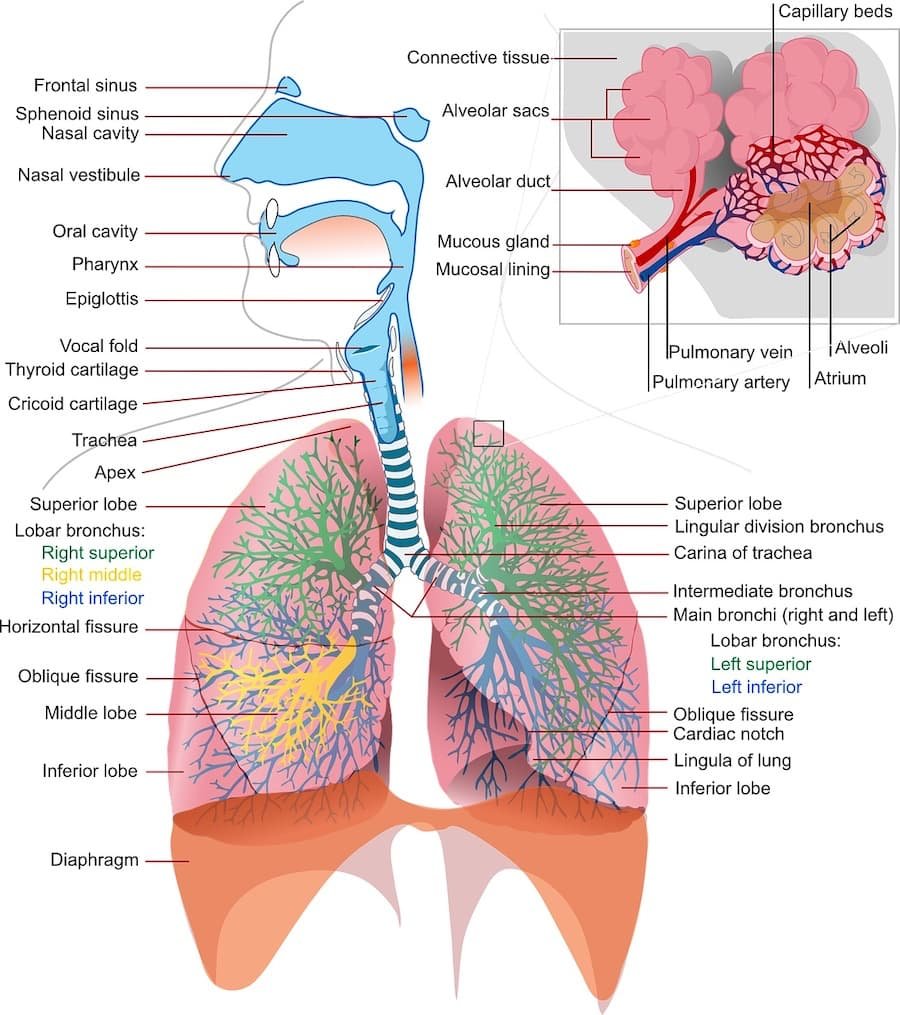
 Nick Pelios
Freediver, Creator
Nick Pelios
Freediver, Creator

 Nick Pelios
Freediver, Creator
Nick Pelios
Freediver, Creator
Breathing is a fundamental process that sustains human life. We often take it for granted, assuming that the air we breathe is abundant and readily available. But have you ever wondered how much air your body can store, or how quickly it is used? In this article, we will delve into the fascinating world of respiratory physiology to understand the capacity of our lungs, the process of gas exchange, and how our body efficiently utilizes the air we breathe.
The lungs are the primary organs responsible for respiration. Each lung is composed of millions of tiny air sacs called alveoli, which are surrounded by a network of blood vessels. When you inhale, the diaphragm and intercostal muscles contract, causing the chest cavity to expand. This expansion creates negative pressure, drawing air into the lungs. On average, an adult human has a lung capacity of about 4-6 liters, depending on factors such as age, gender, and physical condition. However, it's important to note that the lungs are never completely empty or full. Even after a forceful exhale, a small amount of air remains in the lungs to prevent them from collapsing. This residual volume, which cannot be voluntarily expelled, accounts for approximately 1.2 liters of the total lung capacity.

To understand how quickly air is used in the body, we must consider two crucial factors: tidal volume and respiration rate. Tidal volume refers to the amount of air inspired or expired during normal breathing, while respiration rate indicates the number of breaths taken per minute. In a resting state, the average adult breathes at a rate of 12-20 breaths per minute, with a tidal volume of around 500 milliliters. Therefore, the minute ventilation (the total volume of air moved in and out of the lungs in one minute) can be calculated by multiplying tidal volume by respiration rate. For example, if we consider a tidal volume of 500 milliliters and a respiration rate of 15 breaths per minute, the minute ventilation would be 7.5 liters (0.5 liters/breath * 15 breaths/min).
Once the air enters the lungs, it undergoes a remarkable process called gas exchange. Within the alveoli, oxygen from the inhaled air diffuses across the alveolar walls and enters the bloodstream, binding to hemoglobin in red blood cells. Simultaneously, carbon dioxide, a waste product produced by cellular metabolism, diffuses out of the bloodstream into the alveoli to be exhaled. The rate at which oxygen is consumed by the body depends on various factors, such as physical activity, metabolic rate, and overall health. At rest, an average adult consumes approximately 250 milliliters of oxygen per minute. During exercise, oxygen consumption can increase significantly, reaching values of 2-3 liters per minute or more, depending on the intensity of the activity.

While oxygen is vital for our cells, carbon dioxide, as a waste product, needs to be efficiently eliminated from the body. Carbon dioxide produced during cellular metabolism is transported in the bloodstream primarily as bicarbonate ions (HCO3-) and dissolved carbon dioxide (CO2). In the lungs, carbon dioxide diffuses from the blood into the alveoli to be exhaled. The respiratory system maintains a delicate balance of carbon dioxide levels in the blood through chemoreceptors. These sensors monitor the levels of carbon dioxide and hydrogen ions, which indirectly affect the pH of the blood. When carbon dioxide levels increase, the body responds by increasing respiration to remove excess carbon dioxide. This increased respiration rate helps restore the balance of gases and maintain proper pH levels in the blood. During exercise or strenuous activity, the body produces more carbon dioxide due to increased metabolic demands. This prompts a higher respiration rate, allowing for the efficient removal of carbon dioxide and the intake of fresh oxygen. The respiratory system adjusts dynamically to meet the body's changing needs, ensuring a constant supply of oxygen and the removal of waste gases.

Several factors can influence the rate at which air is used by the body. Physical activity and exercise play a significant role. Engaging in intense workouts or aerobic exercises elevates the body's demand for oxygen, resulting in deeper and more frequent breaths. Athletes or individuals with high fitness levels tend to have greater lung capacity and more efficient oxygen utilization compared to sedentary individuals. Environmental factors such as altitude or depth also affect air usage. At higher altitudes, the air pressure decreases, leading to lower oxygen levels. This triggers an increase in respiration rate to compensate for the reduced oxygen availability. The body adapts to the lower oxygen levels by producing additional red blood cells, which enhances oxygen-carrying capacity. Additionally, certain medical conditions can impact air usage and respiratory efficiency. Chronic obstructive pulmonary disease (COPD), asthma, and lung infections can restrict airflow, reducing lung capacity and impairing oxygen exchange. In these cases, individuals may experience shortness of breath, decreased exercise tolerance, and a higher respiratory rate even during rest.